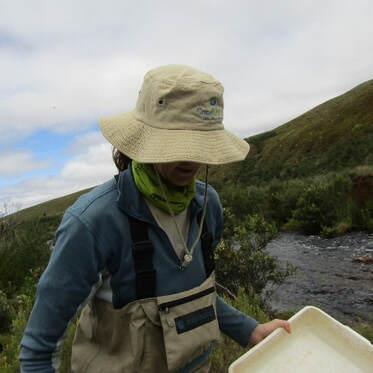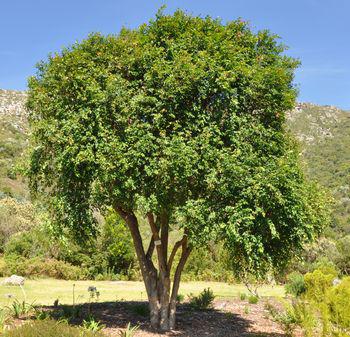|
After many decades of being a steadfast leader for conservation in the Grootvadersbosch Valley, our chairman (John Moodie) is stepping down. “It was exiting to work with people and find new ways to conserve the environment, but fresh input and new ideas are important. “ says John Moodie. John has been chairman of the Grootvadersbosch Conservancy since 1992 and has seen the organisation start and mature. For John, it was a pleasure to see the growth in the organisation and how it has transformed to not just be keepers of the ecosystem but working toward a common goal of protecting the ecosystem. The thought at the start was that a state-owned nature reserve is not enough to conserve this important natural ecosystem and there needed to be other ways in which the environment can be conserved on private land, mainly focusing on alien clearing and fire management. John Moodie, along with Chris Maartens (from Cape Nature at the time) and Keith Moodie’s father Lindsey Moodie put their heads together and started the first Conservancy in the Western Cape in the 90’s. One of the aims was for landowners, in particular, to buy into the project. From the start, it has been a farming community that joins forces with a non-profit trust to promote conservation on private land and that is still how it operates today, although in a different way now. We have 4 permanent staff and much larger budget which mainly goes towards employing people to clear alien vegetation. Today, the services that the conservancy perform have also broaden to include protecting river species, forest restoration, training as well as environmental education projects and all in a non-profit trust. When I asked John what he has gained from being the chair, he smiled and asked, “How does one measure gain?” I smiled, awkwardly. As a student to conservation, I certainly don’t really know what answer to give. I waited intently for insight from someone who has been in conservation for so many years. I was eager to learn from years of experience, in conservation and agriculture. “You implement,” he said. “Sometimes, something works and sometimes it doesn’t. You loose and you win and learn from it and know what to do or what to apply next. Conservation has to be about doing and not just about talking about doing.” He reflected further on the many years and experiences of being a chair. “While being the chair, I had good years of experience and growth. I’ve enjoyed the festivals (thee silver mountain music festival), trail runs, conferences and events that I’ve attended or been part of while being part of the conservancy. It was always good and always exiting. I am immensely proud of the many awards that the conservancy has achieved, while I was on board. There have been mistakes and challenges, but we kept on learning and doing.” I asked John what makes this organisation different from others. He reflected that the organisation has three different pillars that work together-the conservancy landowners, the trustees of the trust and the implementing team or staff. This is a unique and important synergy. The next unique aspect that stood out for him was the fact that landowner do not reap direct financial benefit from this organisation but are positive about the work of the conservancy in terms of alien clearing, tourism, and fire management. This work does increase the value of the land but there are not always direct financial returns.
John was hesitant to offer advice for a new chairperson but said he would rather not dictate how the next person does his or her work but rather offered to make himself available for help and advice. “Let there be room for mistakes, learn from them and become wiser.” Thankfully, John is still on the conservancy committee and so we still have access to his wisdom from many years of experience in the valley. We are incredibly lucky to have had such a wise, steadfast and influential chair in the conservancy for so long and pleased that he is still at hand to assist whenever needed. The conservancy is deeply grateful for all the time that John has volunteered to lead the organisation and we certainly would not be where we are without him. We hope that he will now have more time to enjoy the restful beauty of the valley that he loves so much.
0 Comments
Jeanne Gouws is a freshwater ecologist working for Cape Nature, based in the Western Cape. She regularly visits the Grootvadersbosch cConservancy to do freshwater monitoring in multiple river sites. She captures macro invertebrates to determine the health and other aspects of the river systems. I asked Jeanne what her favorite tree is, and she said without hesitation: “The fever tree is beautiful, and it is my favorite.” The tree is not found naturally in the Grootvadersbosch Conservancy or in the Western Cape but is a renowned feature in the lowveld of South Africa (Plant ZA). The fever tree occurs in spaces where underground water is present, or surface water accumulates, after summer rains (Plant ZA), also in low-lying swampy areas, along rivers. This sounds just like where our freshwater ecologist spends most of her time! The tree can be found from Kenya in the north to KwaZulu-Natal in the South. It is a very beautiful South African tree and, although it is not found here, because it is “Jeanne’s tree”, we are highlighting it anyway. The fever tree or Koorsboom (Vachellia xanthophloea) is a striking tree. The most interesting trait of the tree is the lime green to greenish-yellow, smooth bark. It is coated with a yellow-green, powdery substance which comes away when you rub it with your finger. The flowers are bright yellow and have a sweet scent (Plant ZA). The pods are flat with thin valves, yellowish brown to brown, slightly constricted between the seeds, hairless and somewhat straight (Van Wyk and van Wyk.,2013). The fever tree has lengthy straight white thorns which are gathered in pairs. The thorns differ from young trees to older ones. The thorns aid as a defense mechanism against herbivore predation (Milewski., et. al 1991). The name has an interesting origin. Early settlers thought that this tree caused fevers since people traveling or living in the areas where it grew contracted fevers. However, the fever tree grows in swampy areas that is ideal breeding ground for mosquitoes. Mosquitoes carried malaria so it was this myth that linked this tree to fever and hence the name “fever tree”. The tree provides food and protection for many animals. Birds like to build their nest in the tree because the thorns give them extra protection against predators. Elephants munch on the branches, giraffes and monkeys eat the pods, grey louries eat the flowers, baboons eat the gum and green seeds of the tree. Bees are also drawn to the yellow-colored flowers and the sweet scent. The tree provides a home for ants that are housed in the swollen thorns of the fever tree (Isbell., et. al 2013). The tree has multiple uses for humans too. The wood is hard and suitable for Timber. The bark of the tree is used as raw material in traditional medicine (Kotina et al, 2016). The bark is used for fever and eye problems (Plant ZA). The tree provides lovely shade for humans and other plants growing beneath or around it. A lovely garden tree. Finally, this plant plays a vital role in the nitrogen enrichment of soils, and this has a positive impact on the growth of other plants growing near it. The reason for this is because the tree has root nodules that contain nitrogen fixing bacteria. This is a very interesting tree indeed and we can see why Jeanne loves this tree. Truly special! Stay tuned for our next tree! References
http://pza.sanbi.org/vachellia-xanthophloea Isbell, L.A., Rothman, J.M., Young, P.J. and Rudolph, K., 2013. Nutritional benefits of Crematogaster mimosae ants and Acacia drepanolobium gum for patas monkeys and vervets in Laikipia, Kenya. American Journal of Physical Anthropology, 150(2), pp.286-300. Kotina, E.L., Tilney, P.M., and van Wyk, B.E., 2016. Identification of South African medicinal barks. Planta Medica, 82(S 01), p.P222. Milewski, A.V., Young, T.P. and Madden, D., 1991. Thorns as induced defenses: experimental evidence. Oecologia, 86(1), pp.70-75. Van Wyk, B., 2013. Field guide to trees of southern Africa. Penguin Random House South Africa. Common names:Tree-fuchsia. notsung The tree-fuchsia is usually a shrub or a small tree that occurs in the forest areas or grassland. It often grows along streams or in rocky places (Van Wyk.,2013). Ricardo Januarie our alien clearing project manager at the conservancy speaks about his favourite tree and says, “Oh I love this tree because of all the different kinds of birds that it attracts and its shape when fully grown”. The tree-fuchsia has these bright orange flowers which attract nectar feeding birds. Bees and other insects are also seen feeding on its flowers.” This tree flowers from May to December (Autumn to summer). The flowers are small in red clusters. Sunbirds (except the greater double collared sunbird) and sugarbirds usually feeds on the nectar of the flowers (Stirton.,1977). The tree has a fleshy fruit (Adedapo et., al.2008) and these turn black when they ripen. The fruit is edible but not appetizing (Van Wyk.,2013). Times for fruiting is August until January (Plantbook.co.za). Various parts of the fruit are used in traditional medicine. It has antibacterial and antioxidant properties in both the leaves and stems (Adelapo et., al.2008). Halleria lucida is used by Zulu tribes to treat skin and ear difficulties. It was traditionally used by the Zulu tribes in the following way - the leaves were dried and then soaked in water and then squeezed into the ear to relieve pain. The tree is also considered a charm against evil (Adelapo et., al.2008). The leaves can be eaten by livestock, including wild animals such as Eland (Adelapo et., al 2008). The wood is hard enough to make panga handles with (Trees SA) and is a good container plant and is low maintenance when growing in a garden (Trees SA). Look out for this amazing indigenous tree in your local nursery. Stay tuned for other exciting trees. References.
Adedapo, A.A., Jimoh, F.O., Koduru, S., Masika, P.J. and Afolayan, A.J., 2008. Evaluation of the medicinal potentials of the methanol extracts of the leaves and stems of Halleria lucida. Bioresource technology, 99(10), pp.4158-4163. http://pza.sanbi.org/halleria-lucida http://treesa.org/halleria-lucida/ Stirton, C.H., 1977. A note on the flowers of Halleria lucida. Bothalia, 12(2), pp.223-224. Van Wyk, B., 2013. Field guide to trees of southern Africa. Penguin Random House South Africa. |
AuthorGVB Conservancy Staff Archives
May 2024
Categories |








 RSS Feed
RSS Feed






